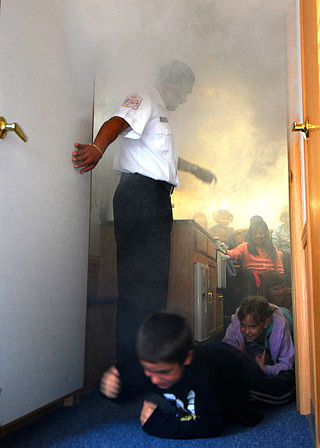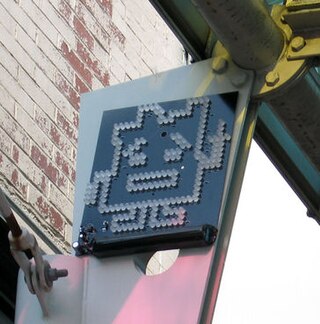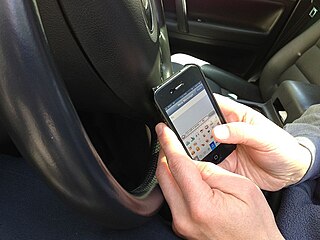
Gun safety is the study and practice of using, transporting, storing and disposing of firearms and ammunition, including the training of gun users, the design of weapons, and formal and informal regulation of gun production, distribution, and usage, for the purpose of avoiding unintentional injury, illness, or death. This includes mishaps like accidental discharge, negligent discharge, and firearm malfunctions, as well as secondary risks like hearing loss, lead poisoning from bullets, and pollution from other hazardous materials in propellants and cartridges. There were 47,000 unintentional firearm deaths worldwide in 2013.

A fire drill is a method of practicing how a building would be evacuated in the event of a fire or other emergencies. In most cases, the building's existing fire alarm system is activated and the building is evacuated by means of the nearest available exits, as if an emergency had actually occurred. Fire drill procedures may vary depending on the building type, such as hospitals or high rise buildings, where occupants may be relocated within the building as opposed to evacuating the building. Generally, the evacuation interval is measured to ensure that it is fast enough, and problems with the emergency system or evacuation procedures are identified so that they may be remedied.

A ringtone, ring tone or ring is the sound made by a telephone to indicate an incoming call. Originally referring to and made by the electromechanical striking of bells, the term now refers to any sound on any device alerting of a new incoming call—up to and including recordings of original telephone bells. On plain old telephone services (POTS), starting in the late 19th century, the required signal is created by superimposing ringing voltage atop the existing voltage. Electric phones could electronically produce a warbling, chirping, or other sounds. Variations on the ring signal can be used to indicate characteristics of incoming calls.

A smoke detector is a device that senses smoke, typically as an indicator of fire. Smoke detectors are usually housed in plastic enclosures, typically shaped like a disk about 150 millimetres (6 in) in diameter and 25 millimetres (1 in) thick, but shape and size vary. Smoke can be detected either optically (photoelectric) or by physical process (ionization). Detectors may use one or both sensing methods. Sensitive alarms can be used to detect and deter smoking in banned areas. Smoke detectors in large commercial and industrial buildings are usually connected to a central fire alarm system.

A fire alarm notification appliance is an active fire protection component of a fire alarm system. A notification appliance may use audible, visible, or other stimuli to alert the occupants of a fire or other emergency condition requiring action. Audible appliances have been in use longer than any other method of notification. Initially, all appliances were either electromechanical horns or electric bells, which would later be replaced by electronic sounders. Most of today's appliances produce sound levels between 70 and 100 decibels at three feet.
A buzzer or beeper is an audio signaling device, which may be mechanical, electromechanical, or piezoelectric. Typical uses of buzzers and beepers include alarm devices, timers, train and confirmation of user input such as a mouse click or keystroke.

An alarm clock or alarm is a clock that is designed to alert an individual or group of individuals at a specified time. The primary function of these clocks is to awaken people from their night's sleep or short naps; they can sometimes be used for other reminders as well. Most alarm clocks make sounds; some make light or vibration. Some have sensors to identify when a person is in a light stage of sleep, in order to avoid waking someone who is deeply asleep, which causes tiredness, even if the person has had adequate sleep. To turn off the sound or light, a button or handle on the clock is pressed; most clocks automatically turn off the alarm if left unattended long enough. A classic analog alarm clock has an extra hand or inset dial that is used to show the time at which the alarm will ring. Alarm clock functions are also used in mobile phones, watches, and computers.

A radar detector is an electronic device used by motorists to detect if their speed is being monitored by police or law enforcement using a radar gun. Most radar detectors are used so the driver can reduce the car's speed before being ticketed for speeding. In general sense, only emitting technologies, like doppler RADAR, or LIDAR can be detected. Visual speed estimating techniques, like ANPR or VASCAR can not be detected in daytime, but technically vulnerable to detection at night, when IR spotlight is used. There are no reports that piezo sensors can be detected. LIDAR devices require an optical-band sensor, although many modern detectors include LIDAR sensors. Most of today's radar detectors detect signals across a variety of wavelength bands: usually X, K, and Ka. In Europe the Ku band is common as well. The past success of radar detectors was based on the fact that radio-wave beams can not be narrow-enough, so the detector usually senses stray and scattered radiation, giving the driver time to slow down. Based on a focused laser-beam, LIDAR technology does not suffer this shortcoming; however it requires precise aiming. Modern police radars incorporate formidable computing power, producing a minimum number of ultra-short pulses, reusing wide beams for multi-target measurement, which renders most detectors useless. But, mobile Internet allows GPS navigation devices to map police radar locations in real-time. These devices are also often called "radar detectors", while not necessary carrying an RF sensor.

Ephebiphobia is the fear of youth. First coined as the "fear or loathing of teenagers", today the phenomenon is recognized as the "inaccurate, exaggerated and sensational characterization of young people" in a range of settings around the world. Studies of the fear of youth occur in sociology and youth studies. It is distinguished from pedophobia by being more focused on adolescents than prepubescent children.

Childproofing is the act of making an environment or object safe for children. This reduces risks to a level considered acceptable by a society, an institution, or to specific parents. Childproofing may include restriction of children to safe areas or preventing children from reaching unsafe areas. This can be accomplished by the parent or by hiring a professional for assistance. Childproofing is gaining more prominence now that parents have greater access to information on child injury and a wide variety of products are available to help prevent it. It has become so top-of-mind for parents that even hotels and child-friendly resorts are offering "child-proof" rooms.
Auditory integration training (AIT) is a procedure pioneered in France by Guy Bérard, who promoted it as a cure for clinical depression and suicidal tendencies, along with what he said were very positive results for dyslexia and autism, although there has been very little empirical evidence regarding this assertion. It typically involves 20 half-hour sessions over 10 days listening to specially filtered and modulated music. It was used in the early 1990s as a treatment for autism; it has been promoted as a treatment for ADHD, depression, and a wide variety of other disorders. AIT has not met scientific standards for efficacy that would justify its use as a treatment for any condition.
The vuvuzela is a horn, with an inexpensive injection-moulded plastic shell about 65 centimetres (2 ft) long, which produces a loud monotone note, typically around B♭ 3. Some models are made in two parts to facilitate storage, and this design also allows pitch variation. Many types of vuvuzela, made by several manufacturers, may produce various intensity and frequency outputs. The intensity of these outputs depends on the blowing technique and pressure exerted. The extreme indoor noise level caused the U.S. NCAA to permanently ban them after the February 7, 1987 Division I Men's Ice Hockey game between Brown University at Rensselaer Polytechnic Institute was so extreme from the 2 ft long cherry-red plastic horns that Brown formally complained and "The RPI Rule" was universally adopted.

On the morning of January 31, 2007, the Boston Police Department and the Boston Fire Department mistakenly identified battery-powered LED placards depicting the Mooninites, characters from the Adult Swim animated television series Aqua Teen Hunger Force, as improvised explosive devices (IEDs), leading to a massive panic. Placed throughout Boston, Massachusetts, and the surrounding cities of Cambridge and Somerville by Peter "Zebbler" Berdovsky and Sean Stevens, these devices were part of a nationwide guerrilla marketing advertising campaign for Aqua Teen Hunger Force Colon Movie Film for Theaters.
Electronic pest control is the name given to any of several types of electrically powered devices designed to repel or eliminate pests, usually rodents or insects. Since these devices are not regulated under the Federal Insecticide, Fungicide, and Rodenticide Act in the United States, the EPA does not require the same kind of efficacy testing that it does for chemical pesticides.

A mobile phone is a portable telephone that can make and receive calls over a radio frequency link while the user is moving within a telephone service area, as opposed to a fixed-location phone. The radio frequency link establishes a connection to the switching systems of a mobile phone operator, which provides access to the public switched telephone network (PSTN). Modern mobile telephone services use a cellular network architecture and therefore mobile telephones are called cellphones in North America. In addition to telephony, digital mobile phones support a variety of other services, such as text messaging, multimedia messagIng, email, Internet access, short-range wireless communications, satellite access, business applications, video games and digital photography. Mobile phones offering only basic capabilities are known as feature phones; mobile phones which offer greatly advanced computing capabilities are referred to as smartphones.

Texting while driving, also called texting and driving, is the act of composing, sending, or reading text messages on a mobile phone while operating a motor vehicle. Texting while driving is considered extremely dangerous by many people, including authorities, and in some places has either been outlawed or restricted. As a form of distracted driving, texting while driving significantly increases the chances that a driver will be involved in a motor vehicle accident.
Cyberbullying or cyberharassment is a form of bullying or harassment using electronic means. Cyberbullying and cyberharassment are also known as online bullying. It has become increasingly common, especially among teenagers and adolescents, due to the communication technology advancements and young people's increased use of such technologies. Cyberbullying is when someone, typically a teenager, bullies or harasses others on the internet and other digital spaces, particularly on social media sites.
Alarm fatigue or alert fatigue describes how busy workers become desensitized to safety alerts, and as a result ignore or fail to respond appropriately to such warnings. Alarm fatigue occurs in many fields, including construction and mining, healthcare, and the nuclear power field. Like crying wolf, such false alarms rob the critical alarms of the importance they deserve. Alarm management and policy are critical to prevent alarm fatigue.

Juul Labs, Inc. is an American electronic cigarette company that spun off from Pax Labs in 2017. Juul Labs makes the Juul electronic cigarette, which atomizes nicotine salts derived from tobacco supplied by one-time use cartridges.

System Sensor is a company headquartered in St. Charles, Illinois, dedicated to the research, development and manufacture of fire protection equipment. System Sensor is a part of the Honeywell Life Safety Group. System Sensor develops and distributes fire alarm devices such as notification appliances, fire detectors, manual initiating devices, CO detectors, and more fire protection devices for multiple markets across the globe, and for other Honeywell companies.















